Reptiles and Amphibians
Media

Species Types
Scientific Name
Necturus maculosus maculosus
Description
Mudpuppies are aquatic salamanders that have plumelike external gills throughout their entire lives. They’re found in the southern half and along the eastern edge of Missouri.
Media

Species Types
Scientific Name
Cryptobranchus alleganiensis alleganiensis
Description
The eastern hellbender is a large, entirely aquatic salamander with a wide, flat head, small, lidless eyes, and soft folds of skin on the sides. In Missouri, it occurs in the northern Ozark highlands in spring-fed rivers that drain north into the Missouri and Meramec river drainages.
Media

Species Types
Scientific Name
Ambystoma talpoideum
Description
The mole salamander is broad-headed, dull gray or brown, with a small body and tail and large limbs. It spends almost all its time below ground. In Missouri, it is restricted to the lowlands of our southeastern counties.
Media

Species Types
Scientific Name
Plethodon angusticlavius
Description
The Ozark zigzag salamander is small and slender, with a narrow, somewhat lobed back stripe that can be yellow, orange, or red. This woodland species lives in Missouri’s southwestern counties along the Arkansas border.
Media

Species Types
Scientific Name
Plethodon albagula
Description
The western slimy salamander is a black to blue-black salamander irregularly marked with silvery flecks. It occurs in the Ozark Highlands and the Lincoln Hills north of the Missouri River. True to its name, it secretes a thick substance that sticks to skin like glue.
Media

Species Types
Scientific Name
Ambystoma opacum
Description
The marbled salamander is a small, stout salamander with silvery, white, or gray saddle-shaped markings on its body from head to tail. They occur in the southeastern half of the state and are seldom encountered except during the autumn breeding season.
Media

Species Types
Scientific Name
Ambystoma maculatum
Description
The spotted salamander is one of Missouri's six species of mole salamanders. It is slate black with two irregular rows of rounded yellow spots from the head onto the tail. It occurs in forests in the southern two-thirds of the state.
Media

Species Types
Scientific Name
Amphiuma tridactylum
Description
The three-toed amphiuma is an eel-like, completely aquatic salamander. It has very small forelimbs and hind limbs, each with three tiny toes. In Missouri it’s found only in the Bootheel region.
Media

Species Types
Scientific Name
Siren intermedia nettingi
Description
The western lesser siren is an eel-like, aquatic salamander with external gills, small eyes, small forelimbs with four toes, and no hind limbs. In Missouri, it’s found mostly in the Bootheel and northward in counties near the Mississippi River.
Media

Species Types
Scientific Name
Plethodon serratus
Description
The southern red-backed salamander is small and slender, with a distinct, narrow, red or orange stripe along the back that has saw-toothed edges. It hides under rocks, mosses, and rotten logs in Ozark forests.
See Also
About Reptiles and Amphibians in Missouri
Missouri’s herptiles comprise 43 amphibians and 75 reptiles. Amphibians, including salamanders, toads, and frogs, are vertebrate animals that spend at least part of their life cycle in water. They usually have moist skin, lack scales or claws, and are ectothermal (cold-blooded), so they do not produce their own body heat the way birds and mammals do. Reptiles, including turtles, lizards, and snakes, are also vertebrates, and most are ectothermal, but unlike amphibians, reptiles have dry skin with scales, the ones with legs have claws, and they do not have to live part of their lives in water.





















